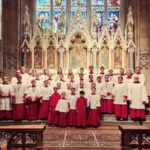A Samaritan woman came to draw water, and Jesus said to her, ‘Give me a drink’. (His disciples had gone to the city to buy food.) The Samaritan woman said to him, ‘How is it that you, a Jew, ask a drink of me, a woman of Samaria?’ (Jews do not share things in common with Samaritans.) Jesus answered her, ‘If you knew the gift of God, and who it is that is saying to you, “Give me a drink”, you would have asked him, and he would have given you living water.’ The woman said to him, ‘Sir, you have no bucket, and the well is deep. Where do you get that living water? Are you greater than our ancestor Jacob, who gave us the well, and with his sons and his flocks drank from it?’ Jesus said to her, ‘Everyone who drinks of this water will be thirsty again, but those who drink of the water that I will give them will never be thirsty. The water that I will give will become in them a spring of water gushing up to eternal life.’ The woman said to him, ‘Sir, give me this water, so that I may never be thirsty or have to keep coming here to draw water.’
In his book, ‘How (not) t0 speak of God’, Peter Rollins offers a critique of the Church’s traditional role ‘as an oasis in the desert – offering water to those who are thirsty.’ Instead, he argues for Christian communities to exist more as ‘a desert in the oasis of life, offering silence, space and desolation amidst the sickly nourishment of Western capitalism.’
I am reminded of this as I read the story of the Samaritan woman. Jesus and the woman encounter each other in the heat of the day, away from the Jewish crowds, and alone. The disciples have gone in search of (sickly?) nourishment elsewhere. Divinity (with a human thirst for water) meets humanity (with a quest for divine connection) across the void of a deep well, a space that is quiet, transformative, and holy.
At its best, liturgical worship offers such space. It yields to the limits of language. It uses art, poetry and music to express the ineffable beauty of the Creator, and our aching desire for communion with God. It stands in silence, acknowledging both the presence of the divine, and the presence of divine absence within our thirsty souls.
Recently, I’ve been talking with choristers about the importance of the Eucharist, and its pivotal place in worship. There has been some lively discussion, and I’ve been impressed by the deep appreciation of our youth for something so mysterious that it stands outside the world of words.
At the 11.00am service this morning you’ll hear Bread of the World, in Mercy Broken, a text especially set for the St Cecilia Choir of Girls. The quietest organ chord (played high up on the strings) follows its closing words, ‘heavenly food’. This is meant to signify the only acceptable response to the proposition that humans consume the Bread of Life: awestruck silence. For how can this truly be possible?
 Peter Rollins would argue that, like the Samaritan woman, such an encounter is only possible in the desert. For, ‘it is in this desert, as we wander together as nomads, that God is to be found. For it is here that we are nourished by our hunger.’
Peter Rollins would argue that, like the Samaritan woman, such an encounter is only possible in the desert. For, ‘it is in this desert, as we wander together as nomads, that God is to be found. For it is here that we are nourished by our hunger.’
Let us enter the desert this Lent. Let us acknowledge that hunger deep within us. Let us meet God in worship that is quiet, transformative, and holy.
Lent 2017


